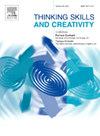An appropriate double blended learning environment based on the 4C/ID model to develop design thinking mindset
IF 3.7
2区 教育学
Q1 Social Sciences
引用次数: 0
Abstract
Purpose
Double blended learning is a unique and novel integration of teaching and learning contexts described in the 4C/ID paradigm. However, this issue still needs more investigation. The research compares the two levels of integration within the task in the 4C/ID model, i.e., the integration of a face-to-face classroom environment with a real work environment and the integration of a face-to-face classroom environment with a simulated environment, to develop students' design thinking and learning outcomes. The design thinking mindset allows learners to develop different levels of cognitive processes, including thinking skills, research skills, learning skills, self-exploration, creativity, and innovation. It also aids them to get set for the labor market and society.
Method
This research employed a pre-test, post-test experiment with a control group. The research subjects were selected from students of the educational sciences at Ferdowsi University of Mashhad, Iran. A total of 48 students were selected as a sample using convenience sampling, 24 of whom were randomly allocated to the experimental group and 24 were placed in the control group.
Results
Statistical analysis (ANCOVA and MANCOVA) showed that being in the real work environment improved learning outcomes and developed a design-thinking mindset compared to the simulated environment.
Conclusions
Acquiring the competency of a design thinking mindset is a complex learning process. Based on the results of this study, it can be said that presence in the real environment improves learning outcomes and the development of design thinking in educational programs for students of educational sciences.
求助全文
约1分钟内获得全文
求助全文
来源期刊

Thinking Skills and Creativity
EDUCATION & EDUCATIONAL RESEARCH-
CiteScore
6.40
自引率
16.20%
发文量
172
审稿时长
76 days
期刊介绍:
Thinking Skills and Creativity is a new journal providing a peer-reviewed forum for communication and debate for the community of researchers interested in teaching for thinking and creativity. Papers may represent a variety of theoretical perspectives and methodological approaches and may relate to any age level in a diversity of settings: formal and informal, education and work-based.
 求助内容:
求助内容: 应助结果提醒方式:
应助结果提醒方式:


